Superfund Research Program Progress in Research Webinar Part 4: Boston University, Texas A&M University, and University of California, Davis
Sponsored by: NIEHS Superfund Research Program
Archived: Monday, October 1, 2018
Superfund Research Program Progress in Research Webinar Part 4: Boston University, Texas A&M University, and University of California, Davis
2018-10-01
NIEHS Superfund Research Program
This Superfund Research Program (SRP) Progress in Research webinar series highlights promising research from SRP Centers awarded grants in 2017. In this session, awardees Boston University, Texas A&M University, and University of California, Davis, will describe their research projects, accomplishments, and next steps.
The Boston University SRP Center explores the long-term impacts of early life exposure to Superfund chemicals in humans and wildlife. Their work focuses on contaminants including polychlorinated biphenyls and tetrachloroethylene found in and around the New Bedford Harbor Superfund site and in drinking water of nearby communities.
The Texas A&M University SRP Center focuses on developing comprehensive tools and models for addressing exposure to mixtures during emergency-related environmental contamination events. The researchers are evaluating the complexities of hazardous chemical exposures, potential adverse health impacts, and potential hazards of exposures to complex mixtures through projects that derive from a case study utilizing the Texas Galveston Bay area.
The University of California, Davis SRP Center uses integrated chromatographic, biosensor, and cell-based technologies to detect and identify contaminants and develop innovative approaches for bioremediation. The Center is expanding the use of transcriptomics, proteomics, metabolomics, and integrated bioinformatics technologies to discover new mechanisms of action of hazardous materials and biological markers for their action and to connect hazardous substance exposures to organism level effects.
Accessibility, Recording, and Content Disclaimer
Rehabilitation Act Notice for Reasonable Accommodation
It is EPA's policy to make reasonable accommodation to persons with disabilities wishing to participate in the agency's programs and activities, pursuant to the Rehabilitation Act of 1973, 29 U.S.C. 791. Any request for accommodation should be made to Sara Amolegbe at 919-794-4700 or samolegbe@michaeldbaker.com, preferably one week or more in advance of the webinar, so that EPA will have sufficient time to process the request. EPA would welcome specific recommendations from requestors specifying the nature or type of accommodation needed. Please note that CLU-IN provides both alternate phone call-in options and closed captioning for all webinars, and requests for these specific accommodations are not necessary.
Webinar Recording
By participating in this CLU-IN webinar, you automatically agree to authorize recording of audio and visual content presented during this live event and consent to subsequent use of this recording in the public domain by the U.S. Environmental Protection Agency. This recording may include questions, comments and poll responses provided by you during the live event in addition to your name, voice, image or likeness. This recording will be made available after the conclusion of the live event as part of the CLU-IN webinar archives, and will remain available indefinitely. If you do not wish to consent to the recording, please do not join the live event, and contact Jean Balent at 202-566-0832 or balent.jean@epa.gov to discuss your concerns.
Content Disclaimer
This webinar is intended solely to provide information to the public. The views and opinions expressed as part of this webinar do not necessarily state or reflect those of the U.S. Environmental Protection Agency. It is not intended, nor can it be relied upon, to create any rights enforceable by any party in litigation with the United States, or to endorse the use of products or services provided by specific vendors. With respect to this webinar, neither the United States Government nor any of their employees, makes any warranty, express or implied, including the warranties of merchantability and fitness for a particular purpose, or assumes any legal liability or responsibility for the accuracy, completeness, or usefulness of any information, apparatus, product, or process disclosed, or represents that its use would not infringe privately owned rights.
Presenters:
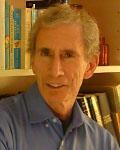 David Sherr, Ph.D., Boston University (dsherr@bu.edu or 617-638-6463)
David Sherr, Ph.D., Boston University (dsherr@bu.edu or 617-638-6463)
Since 1993, David Sherr, Ph.D., and his research team have conducted research on how common environmental pollutants, such as dioxins, polycyclic aromatic hydrocarbons and PCBs, adversely affect the growth and behavior of several different types of normal and malignant cells. In previous work, the Sherr laboratory studied how environmental chemicals affect the development of the immune system. His laboratory demonstrated that aromatic hydrocarbons compromise the function of bone marrow cells required for the development of antibody-forming cells. These cells are critical for immune protection against viruses and bacteria. More recently, Sherr's laboratory has focused on the molecular mechanisms that initiate and maintain breast cancer and on the effects of environmental chemicals on these processes. The laboratory has shown that a cellular protein receptor, referred to as the aryl hydrocarbon receptor (AhR), plays an important role in the initiation and progression of human breast cancer. A new area of study in Sherr's laboratory is the analysis of the role of the AhR in blood cell development. Sherr is the director of the Boston University SRP Center and the Immunology Training Program, and a member of the Amyloid Treatment Research Program, the BU Cancer Center, the Hematology/Oncology Training Program, and the BU Hormone-dependent Cancer Center.
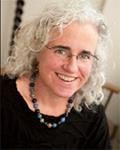 Wendy Heiger-Bernays, Ph.D., Boston University (whb@bu.edu or 617-638-4620)
Wendy Heiger-Bernays, Ph.D., Boston University (whb@bu.edu or 617-638-4620)
Wendy Heiger-Bernays, Ph.D., is a faculty member in the department of environmental health at the BU School of Public Health where she applies her training in molecular toxicology to practical questions about the impact of industrial chemicals, consumer products and pharmaceuticals in waste streams on people's health. She works collaboratively to assess toxicity of chemicals that are able to modify the metabolic pathways in juvenile and prenatal fish and rodent models, to characterize and screen chemicals with endocrine activity in water, characterize health risks posed by vapors in homes that originate beneath the ground, and the development of practical interventions to commonly measured chemical hazards in agricultural soils. Dr. Heiger-Bernays leads the Research Translation Core (RTC) for the NIEHS-supported BU Superfund Program. Her work on the RTC is focused on technology and information transfer of the science to multiple audiences, including environmental regulatory and health agencies as well as with advocacy groups and community groups. Her research and teaching include a focus on effective ways to translate findings from the laboratory to multiple audiences. Heiger-Bernays' overall objective is to engage communities in their understanding and mitigation of environmental health risks. She currently serves as a member of the Massachusetts DEP Waste Site Advisory Committee and the Science Advisory Board for the Toxics Use Reduction Institute and is chair of her local board of health. In 2015-2016, she was an AAAS Science and Technology Fellow hosted in the Office of Science Coordination and Policy at the US EPA, working in the Endocrine Disrupting Screening Program.
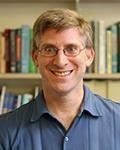 Jonathan Levy, Sc.D.,, Boston University (jonlevy@bu.edu or 617-638-4663)
Jonathan Levy, Sc.D.,, Boston University (jonlevy@bu.edu or 617-638-4663)
Jonathan Levy, Sc.D., is a professor in the department of environmental health at the BU School of Public Health. His research centers on urban environmental exposure and health risk modeling, with an emphasis on spatiotemporal exposure patterns and related environmental justice issues. Recent and ongoing research topics include evaluating spatial patterns of air pollution in complex urban terrain, developing methods to quantify the magnitude and distribution of health benefits associated with energy efficiency and renewable energy measures, using systems science approaches to evaluate the benefits of housing interventions on pediatric asthma, and developing methods for community-based cumulative risk assessment that includes chemical and non-chemical stressors. He co-directs the Center for Research on Environmental and Social Stressors in Housing Across the Life Course (CRESSH), which involves interdisciplinary research activities connecting environmental epidemiology, exposure science, and health disparities modeling, with a focus on the indoor environment and community-engaged research. He has been a member of several National Research Council committees, including the Committee on Science for EPA's Future, the Committee on Health Impact Assessment, and the Committee on Improving Risk Analysis Approaches Used by the US Environmental Protection Agency. He also served on the Advisory Council on Clean Air Compliance Analysis, which provided guidance to EPA on the impact of the Clean Air Act on health, the economy, and the environment.
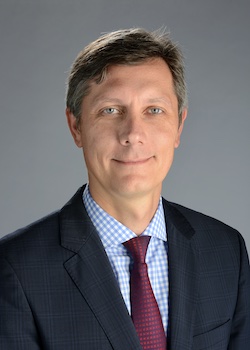 Ivan Rusyn, Ph.D., Texas A&M University (irusyn@cvm.tamu.edu)
Ivan Rusyn, Ph.D., Texas A&M University (irusyn@cvm.tamu.edu)
Ivan Rusyn is University Professor in the Department of Veterinary Physiology and Pharmacology in the College of Veterinary Medicine & Biomedical Sciences at Texas A&M University in College Station. He is also Chair of the Interdisciplinary Faculty of Toxicology, Director of an NIEHS T32 training program in “Regulatory Science in Environmental Health and Toxicology,” and Director of the Superfund Research Center. His studies on health effects of chemical agents resulted in over 310 peer-reviewed publications which were cited over 30,000 times. He has served on and chaired several US National Academies committees, World Health Organization/International Agency for Research on Cancer monograph working groups. He is serving on the advisory board for Texas Department of Public Health, and on the Research Committee of the Health Effects Institute. Dr. Rusyn received a doctor of medicine degree from Ukrainian State Medical University in Kyiv and a Ph.D. in toxicology from the University of North Carolina at Chapel Hill. He conducted postdoctoral research at the Massachusetts Institute of Technology and Heinrich-Heine University in Dusseldorf. Dr. Rusyn's laboratory is funded by grants and cooperative research agreements from the National Institutes of Health and US Environmental Protection Agency, institutional funding from Texas A&M University, the industry, and other sources.
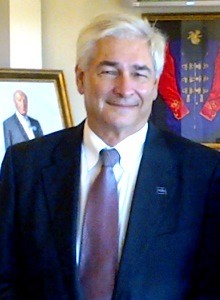 Anthony Knap, Ph.D., Texas A&M University (tknap@tamu.edu or 979-458-9328)
Anthony Knap, Ph.D., Texas A&M University (tknap@tamu.edu or 979-458-9328)
Anthony Knap, Ph.D. is the James R. Whatley Endowed Chair in Geosciences, a professor in the department of oceanography, and director of the Geochemical and Environmental Research Group at Texas A&M University. He leads a Texas A&M Center project focused on the redistribution of contaminated sediments from both soils and marine sediments as a consequence of natural disasters such as floods and storms. Knap’s primary research focuses include oceanography, organic geochemistry, environmental science, atmosphere/ocean interactions, oil pollution and dispersant use, and effects of contaminants on the marine environment. Global climate change is another area of interest, particularly climate instability, business/science interactions, renewable energy, marine derived bio-fuels, ocean genomics, ocean acidification. He was founder and principal investigator of the NSF-funded Bermuda Atlantic Time-series Study (BATS) off Bermuda. He was also the principal investigator for 30 years of Hydrostation S, founded in 1954 and the longest continuous time-series in the Ocean, also funded by NSF. He was most recently appointed to the Gulf Research Board of the U.S. National Academy of Sciences. He received his Ph.D. in chemical oceanography at the University of Southampton in Southampton, England.
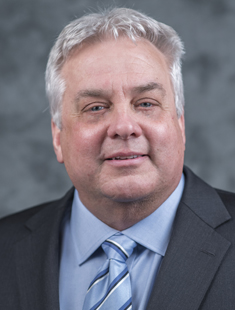 Thomas McDonald, Ph.D., Texas A&M University (tmcdonald@sph.tamhsc.edu or 979-436-9425)
Thomas McDonald, Ph.D., Texas A&M University (tmcdonald@sph.tamhsc.edu or 979-436-9425)
Thomas McDonald, Ph.D., is a professor of environmental and occupational health at Texas A&M University. He leads the Texas A&M Center Research Translation Core, which aims to improve the identification, characterization, and remediation of chemical contamination from natural and man-made disasters through communication and technology transfer of Texas A&M SRP Center research findings to multiple stakeholders. His research and teaching interests include environmental chemistry, petroleum geochemistry, and general organic chemistry. He received his Ph.D. in oceanography at Texas A&M.
 Bruce Hammock, Ph.D., University of California-Davis (bdhammock@ucdavis.edu or 530-752-7519)
Bruce Hammock, Ph.D., University of California-Davis (bdhammock@ucdavis.edu or 530-752-7519)
Bruce Hammock, Ph.D., is a distinguished professor in the department of entomology at the University of California, Davis. He also holds a joint appointment with the UC Davis Comprehensive Cancer Center and directs the UC Davis SRP Center. His team of over 40 scientists and students employ a multidisciplinary, integrated approach to research that delves into basic questions of biology and biochemistry that have practical implications for improving both human and environmental health. Hammock is best known for his discovery of soluble epoxide hydrolase, an enzyme in cells that degrades chemically stable fatty acid epoxides. Hammock’s NIEHS-funded laboratory has also pioneered the use of immunoassay technologies to detect hazardous chemicals. Hammock is a member of the National Academy of Sciences, a fellow of the Entomological Society of America, and the recipient of the 2001 UC Davis Faculty Research Lecture Award and the 2008 Distinguished Teaching Award for Graduate and Professional Teaching. He received his Ph.D. in entomology and toxicology from the University of California, Berkeley.
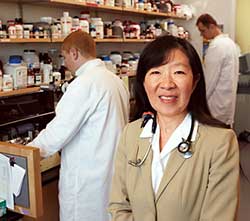 Nipavan Chiamvimonvat, M.D., University of California, Davis (nchiamvimonvat@ucdavis.edu or 530-754-7158)
Nipavan Chiamvimonvat, M.D., University of California, Davis (nchiamvimonvat@ucdavis.edu or 530-754-7158)
Nipavan Chiamvimonvat, M.D., is a cardiologist and professor in the department of internal medicine at the UC Davis School of Medicine. She leads a UC Davis SRP Center project on focused on the critical role of mitochondrial oxidative stress (MOS) in chemical induced cardiac toxicity. They are developing cell-based assays to evaluate the mechanistic basis of xenobiotic effects on MOS and proteostasis and evaluating the effects of chronic exposure to xenobiotics on increased MOS, apoptosis, fibrosis, heart damage and associated alterations of plasma oxidized protein levels. Her laboratory has focused their research efforts in two major areas in cardiovascular diseases: the study of the functional roles of different isoforms of cardiac calcium and calcium-activated potassium channels using combined techniques of transgenic mouse models, gene silencing, and patch-clamp recordings; and the roles of soluble epoxide hydrolase (she) inhibitors in the prevention of cardiac hypertrophy and failure. She received her M.D. from the University of Toronto.
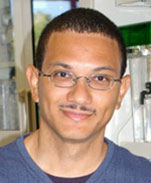 Aldrin Gomes, Ph.D., University of California, Davis (avgomes@ucdavis.edu or 530-752-3207)
Aldrin Gomes, Ph.D., University of California, Davis (avgomes@ucdavis.edu or 530-752-3207)
Aldrin Gomes, Ph.D., is a professor in the department of neurobiology, physiology, and behavior in the UC Davis college of biological sciences and in the department of physiology and membrane biology at UC Davis School of Medicine. His research focuses on the molecular mechanisms of signal transduction, particularly in the role of protein homeostasis in cardiovascular diseases. Impaired protein degradation is associated with many cardiac and skeletal muscle diseases. His laboratory is interested in investigating the signaling pathways involved in protein homeostasis in cardiac and skeletal muscle diseases. His laboratory also investigates the side effects of commonly used drugs, such as ibuprofen, on the heart. He received his Ph.D. in biochemistry from the University of the West Indies, St. Augustine, Trinidad and Tobago.
Moderators:
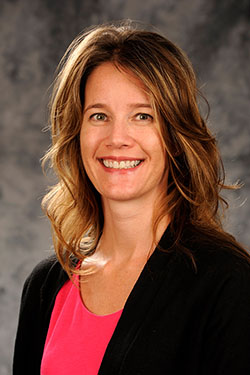 Michelle L. Heacock, Ph.D., NIEHS Superfund Research Program (heacockm@niehs.nih.gov)
Michelle L. Heacock, Ph.D., NIEHS Superfund Research Program (heacockm@niehs.nih.gov)
Michelle Heacock, Ph.D., is currently serving as the acting branch chief of the Hazardous Substances Research Branch, and is a health science administrator where she oversees Superfund Research Program (SRP) grants that span basic molecular mechanisms of biological responses from exposures to hazardous substances, movement of hazardous substances through environmental media, detection technologies, and remediation approaches. Dr. Heacock received her doctorate from Texas A&M University for her work on the interplay between DNA repair proteins and telomeres. Her postdoctoral work was conducted at NIEHS where she studied the DNA repair pathway, base excision repair. She has been with the NIEHS since 2007.
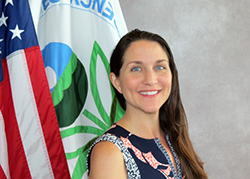 Jean Balent, U.S. EPA Technology Innovation and Field Services Division (balent.jean@epa.gov or 202-566-0832)
Jean Balent, U.S. EPA Technology Innovation and Field Services Division (balent.jean@epa.gov or 202-566-0832)
Ms Balent is on the staff of the EPA's Technology Innovation and Field Services Division where she has worked to collect and disseminate hazardous waste remediation and characterization information since 2003. Ms Balent manages the Clean Up Information Network website and actively supports online communication and collaboration resources available to EPA. She formerly worked with the US Army Corps of Engineers Environmental Engineering Division in the Buffalo District. Ms Balent was also a member of the SUNY-Buffalo Groundwater Research Group where she constructed and tested large scale models of groundwater flow. Ms Balent has also conducted research relating to the Great Lakes, environmental remediation, and brownfields re-development. She holds a Bachelor's degree in environmental engineering from SUNY-Buffalo and a Master's degree in Information Technology from AIU.
Webinar Slides and References:
- Slide Presentation for Boston University SRP Center:
- Slide Presentation for Texas A&M University SRP Center:
- Slide Presentation for University of California, Davis SRP Center:
Webinar Slides and References:
- Slide Presentation for Boston University SRP Center:
- Slide Presentation for Texas A&M University SRP Center:
- Slide Presentation for University of California, Davis SRP Center:
Additional Resources:
If you have a suggested topic or idea for a future CLU-IN internet seminar, please contact:
Technology Integration and Information Branch
PH: 202-566-0832 | Email: balent.jean@epa.gov
Technology Integration and Information Branch
PH: 202-566-0875 | Email: adam.michael@epa.gov





